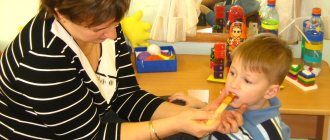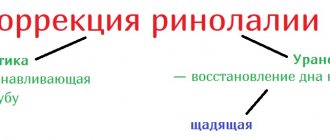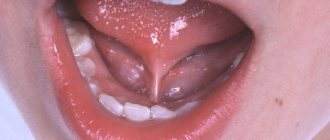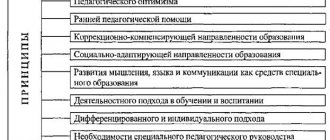Dysarthria is a severe speech disorder, accompanied by a disorder of articulation, phonation, speech breathing, tempo-rhythmic organization and intonation coloring of speech, as a result of which speech loses its articulation and intelligibility. Among children, the prevalence of dysarthria is 3-6%, but in recent years there has been a pronounced upward trend in this speech pathology. In speech therapy, dysarthria is one of the three most common forms of oral speech disorders, second only to dyslalia in frequency and ahead of alalia. Since the pathogenesis of dysarthria is based on organic lesions of the central and peripheral nervous system, this speech disorder is also studied by specialists in the field of neurology and psychiatry.
Causes of dysarthria
Most often (in 65-85% of cases) dysarthria accompanies cerebral palsy and has the same causes. In this case, organic damage to the central nervous system occurs in the prenatal, birth or early periods of child development (usually up to 2 years). The most common perinatal factors of dysarthria are toxicosis of pregnancy, fetal hypoxia, Rhesus conflict, chronic somatic diseases of the mother, pathological course of labor, birth injuries, at birth, kernicterus of newborns, prematurity, etc. The severity of dysarthria is closely related to the severity of motor disorders in cerebral palsy : Thus, with double hemiplegia, dysarthria or anarthria is detected in almost all children.
In early childhood, damage to the central nervous system and dysarthria in a child can develop after suffering neuroinfections (meningitis, encephalitis), purulent otitis media, hydrocephalus, traumatic brain injury, severe intoxication.
The occurrence of dysarthria in adults is usually associated with a stroke, head injury, neurosurgery, and brain tumors. Dysarthria can also occur in patients with multiple sclerosis, amyotrophic lateral sclerosis, syringobulbia, Parkinson's disease, myotonia, myasthenia, cerebral atherosclerosis, neurosyphilis, oligophrenia.
Definition and general information
Dysarthria is a speech therapy disorder. Its frequency is only 3-6% of all children, but there is a tendency for this indicator to increase. The disease is among the three most common speech disorders, along with dyslalia (speech defects not associated with damage to the central nervous system) and alalia (serious disturbances or complete absence of speech in children). Dysarthria occurs due to disruption of the central or peripheral nervous system, which affects the innervation of the muscles of the lips and tongue, larynx, palate, larynx and respiratory muscles.
Classification of dysarthria
The neurological classification of dysarthria is based on the principle of localization and a syndromic approach. Taking into account the localization of damage to the speech-motor apparatus, the following are distinguished:
- bulbar dysarthria associated with damage to the nuclei of the cranial nerves (glossopharyngeal, sublingual, vagus, sometimes facial, trigeminal) in the medulla oblongata
- pseudobulbar dysarthria associated with damage to the corticonuclear pathways
- extrapyramidal (subcortical) dysarthria associated with damage to the subcortical nuclei of the brain
- cerebellar dysarthria associated with damage to the cerebellum and its pathways
- cortical dysarthria associated with focal lesions of the cerebral cortex.
Depending on the leading clinical syndrome, cerebral palsy may include spastic-rigid, spastic-paretic, spastic-hyperkinetic, spastic-atactic, ataxic-hyperkinetic dysarthria.
Speech therapy classification is based on the principle of speech intelligibility for others and includes 4 degrees of severity of dysarthria:
1st degree (erased dysarthria) – defects in sound pronunciation can only be identified by a speech therapist during a special examination.
Grade 2 defects in sound pronunciation are noticeable to others, but overall speech remains understandable.
3rd degree - understanding of the speech of a patient with dysarthria is available only to those close to him and partially to strangers.
4th degree speech is absent or incomprehensible even to the closest people (anarthria).
Cerebellar dysarthria
Cerebellar dysarthria is characterized by disorders associated with the pronunciation side of speech. These disorders are caused by damage to the cerebellum. This form of dysarthria is characterized by the following manifestations:
- loss of fluency of speech;
- disturbance of the rhythm of speech;
- loss of expressiveness;
- slowness and intermittency of speech.
This speech disorder is observed against the background of impaired coordination of movements of various muscles, which is caused by pathology of the cerebellum. Correction of cerebellar dysarthria involves etiopathogenetic treatment of the underlying pathology, drug support, as well as general rehabilitation measures: physical therapy, massage, work with a psychologist, classes with a speech therapist).
Symptoms of dysarthria
The speech of patients with dysarthria is slurred, unclear, and incomprehensible (“porridge in the mouth”), which is due to insufficient innervation of the muscles of the lips, tongue, soft palate, vocal folds, larynx, and respiratory muscles. Therefore, with dysarthria, a whole complex of speech and non-speech disorders develops, which constitute the essence of the defect.
Impaired articulatory motor skills in patients with dysarthria may manifest as spasticity, hypotonia, or dystonia of the articulatory muscles. Muscle spasticity is accompanied by constant increased tone and tension in the muscles of the lips, tongue, face, and neck; tightly closed lips, limiting articulatory movements. With muscle hypotonia, the tongue is flaccid and lies motionless on the floor of the mouth; the lips do not close, the mouth is half open, hypersalivation (salivation) is pronounced; Due to paresis of the soft palate, a nasal tone of voice appears (nasalization). In the case of dysarthria occurring with muscular dystonia, when attempting to speak, muscle tone changes from low to increased.
Sound pronunciation disturbances in dysarthria can be expressed to varying degrees, depending on the location and severity of damage to the nervous system. With erased dysarthria, individual phonetic defects (sound distortions) and “blurred” speech are observed.” With more pronounced degrees of dysarthria, there are distortions, omissions, and substitutions of sounds; speech becomes slow, inexpressive, slurred. General speech activity is noticeably reduced. In the most severe cases, with complete paralysis of the speech motor muscles, motor speech becomes impossible.
Specific features of impaired sound pronunciation in dysarthria are the persistence of defects and the difficulty of overcoming them, as well as the need for a longer period of automation of sounds. With dysarthria, the articulation of almost all speech sounds, including vowels, is impaired. Dysarthria is characterized by interdental and lateral pronunciation of hissing and whistling sounds; voicing defects, palatalization (softening) of hard consonants.
Due to insufficient innervation of the speech muscles during dysarthria, speech breathing is disrupted: exhalation is shortened, breathing at the time of speech becomes rapid and intermittent. Voice disturbances in dysarthria are characterized by insufficient strength (quiet, weak, fading voice), changes in timbre (deafness, nasalization), and melodic-intonation disorders (monotony, absence or inexpressibility of voice modulations).
Due to slurred speech in children with dysarthria, auditory differentiation of sounds and phonemic analysis and synthesis suffer secondarily. The difficulty and insufficiency of verbal communication can lead to an undeveloped vocabulary and grammatical structure of speech. Therefore, children with dysarthria may experience phonetic-phonemic (FFN) or general speech underdevelopment (GSD) and associated corresponding types of dysgraphia.
Symptoms
The main symptoms of bulbar dysarthria:
- The child's speech is slurred, inhibited, with poor articulation. The “R” sounds are replaced with fricative ones. Instead of the sound “B”, the sound “P” is pronounced “V”, the sound “P” changes to “F”.
- Consonant voiced sounds are completely or partially absent. Unstressed and stressed sounds are pronounced the same. The letter "A" sounds best.
- There is a noticeable rhythm disturbance. Speech sounds less emotional and monotonous. Expressive speech is not available to a child with dysarthria.
- The child often chokes and has problems swallowing when eating food and water.
- The child's voice is low and nasal.
- Facial expressions are poorly expressed, facial asymmetry is observed (with unilateral nerve damage).
A child suffering from this type of dysarthria has simple slurred articulation. In some cases, voiced sounds disappear from speech. The deaf begin to dominate them. Speech loses its expressiveness and emotionality; it is not melodic. Expressive speech causes great difficulty for the patient and quickly tires him.
The exact symptoms depend on which cranial nerves are affected. In some cases, all of these symptoms may occur.
Characteristics of clinical forms of dysarthria
Bulbar dysarthria is characterized by areflexia, amymia, disorder of sucking, swallowing solid and liquid food, chewing, hypersalivation caused by atony of the muscles of the oral cavity. The articulation of sounds is slurred and extremely simplified. All the variety of consonants is reduced into a single fricative sound; sounds are not differentiated from each other. Nasalization of voice timbre, dysphonia or aphonia is typical.
With pseudobulbar dysarthria, the nature of the disorder is determined by spastic paralysis and muscle hypertonicity. Pseudobulbar paralysis manifests itself most clearly in impaired tongue movements: great difficulty is caused by attempts to raise the tip of the tongue upward, move it to the sides, or hold it in a certain position. With pseudobulbar dysarthria, switching from one articulatory posture to another is difficult. Typically selective impairment of voluntary movements, synkinesis (conjugal movements); profuse salivation, increased pharyngeal reflex, choking, dysphagia. The speech of patients with pseudobulbar dysarthria is blurred, slurred, and has a nasal tint; the normative reproduction of sonors, whistling and hissing, is grossly violated.
Subcortical dysarthria is characterized by the presence of hyperkinesis - involuntary violent muscle movements, including facial and articulatory movements. Hyperkinesis can occur at rest, but usually intensifies when attempting to speak, causing articulatory spasm. There is a violation of the timbre and strength of the voice, the prosodic aspect of speech; Sometimes patients emit involuntary guttural screams.
With subcortical dysarthria, the tempo of speech may be disrupted, such as bradylalia, tachylalia, or speech dysrhythmia (organic stuttering). Subcortical dysarthria is often combined with pseudobulbar, bulbar and cerebellar forms.
A typical manifestation of cerebellar dysarthria is a violation of the coordination of the speech process, which results in tremor of the tongue, jerky, scanned speech, and occasional cries. Speech is slow and slurred; The pronunciation of front-lingual and labial sounds is most affected. With cerebellar dysarthria, ataxia is observed (unsteadiness of gait, imbalance, clumsiness of movements).
Cortical dysarthria in its speech manifestations resembles motor aphasia and is characterized by a violation of voluntary articulatory motor skills. There are no disorders of speech breathing, voice, or prosody in cortical dysarthria. Taking into account the localization of lesions, kinesthetic postcentral cortical dysarthria (afferent cortical dysarthria) and kinetic premotor cortical dysarthria (efferent cortical dysarthria) are distinguished. However, with cortical dysarthria there is only articulatory apraxia, while with motor aphasia not only the articulation of sounds suffers, but also reading, writing, understanding speech, and using language.
Extrapyramidal dysarthria
Extrapyramidal dysarthria (or subcortical) is a form of speech disorder that occurs as a result of damage to the subcortical nodes and their nerve connections. This pathology is characterized by involuntary movements of the facial and respiratory muscles, as well as involuntary movements of the tongue. Such movements may not appear for some time and intensify when the child tries to make a voluntary movement. At the same time, the pronunciation of individual sounds can be preserved.
Overall speech intelligibility depends on control of speech breathing and voice, and is affected by vocal strength. If the voice sounds good, speech can be quite understandable. The sonority of the voice is inconsistent. As a rule, extrapyramidal dysarthria is characterized by attenuation of the voice towards the end of the phrase. The child's voice may be dull and strained. There is no fluency of speech.
Subcortical dysarthria is characterized by incoordination of the movements of the respiratory and articulatory muscles. The tone of the muscles of the neck and shoulder girdle is often increased. There is no stability in the construction of the phrase. With sharp spasms, speech is impossible. In addition, this form of dysarthria can be combined with hearing impairment such as sensorineural hearing loss.
Diagnosis of dysarthria
The examination and subsequent management of patients with dysarthria is carried out by a neurologist (children's neurologist) and speech therapist. The extent of the neurological examination depends on the expected clinical diagnosis. The most important diagnostic value is given by electrophysiological studies (electroencephalography, electromyography, electroneurography), transcranial magnetic stimulation, MRI of the brain, etc.
Speech therapy examination for dysarthria includes assessment of speech and non-speech disorders. Assessment of non-speech symptoms involves studying the structure of the articulatory apparatus, the volume of articulatory movements, the state of facial and speech muscles, and the nature of breathing. The speech therapist pays special attention to the history of speech development. As part of the diagnosis of oral speech in dysarthria, a study of the pronunciation aspect of speech (sound pronunciation, tempo, rhythm, prosody, speech intelligibility) is carried out; synchronicity of articulation, breathing and voice production; phonemic perception, level of development of the lexico-grammatical structure of speech. In the process of diagnosing written speech, tasks are given for copying text and writing from dictation, reading passages and comprehending what is read.
Based on the examination results, it is necessary to distinguish between dysarthria and motor alalia, motor aphasia, and dyslalia.
Diagnosis of bulbar dysarthria in children
The bulbar form of dysarthria is diagnosed on the basis of a neurological, speech therapy examination and data from instrumental research methods.
The stages are:
- A neurological examination can reveal the localization of bulbar dysarthria and its symptoms (dysphonia and dysphagia), as well as other signs of a neurological disease (facial asymmetry, tongue deviation, muscle atrophy, decreased reflexes). The doctor assesses the prevalence of the pathological process, makes an accurate diagnosis and determines the severity. At this stage, it is important to study the medical history: the course of pregnancy and childbirth, features of early development, previous diseases and injuries;
- Examination by a speech therapist - assessment of voice, speed, rhythm of speech, mobility and coordination of articulatory muscles, the state of facial muscles and breathing. The specialist identifies the characteristics of bulbar dysarthria and determines treatment tactics;
- CT, MRI, electroencephalography, ultrasound, Dopplerography provide information about vascular disorders, organic pathology, space-occupying formations, inflammatory process, degenerative pathology;
- Lumbar puncture is needed to identify the causative agent, therefore it is performed if the infectious-inflammatory nature of the pathology is suspected.
If necessary, the child may be referred for additional research methods and for consultation with other doctors.
Doctors are faced with the task of differentiating the bulbar form of dysarthria from pseudobulbar syndrome, which is caused by damage to the corticobulbar tracts. It is also necessary to exclude motor, acoustic-mnestic and dynamic aphasia.
Correction of dysarthria
Speech therapy work to overcome dysarthria should be carried out systematically, against the background of drug therapy and rehabilitation (segmental reflex and acupressure, acupressure, exercise therapy, medicinal baths, physiotherapy, mechanotherapy, acupuncture, hirudotherapy) prescribed by a neurologist. A good background for correctional and pedagogical classes is achieved by using non-traditional forms of restorative treatment: dolphin therapy, touch therapy, isotherapy, sand therapy, etc.
At speech therapy classes for the correction of dysarthria, the development of fine motor skills (finger gymnastics), motor skills of the speech apparatus (speech therapy massage, articulation gymnastics); physiological and speech breathing (breathing exercises), voice (orthophonic exercises); correction of impaired and consolidation of correct sound pronunciation; work on the expressiveness of speech and the development of verbal communication.
The order of production and automation of sounds is determined by the greatest availability of articulation patterns at the moment. Automation of sounds in dysarthria is sometimes carried out until complete purity of their isolated pronunciation is achieved, and the process itself requires more time and persistence than in dyslalia.
The methods and content of speech therapy work vary depending on the type and severity of dysarthria, as well as the level of speech development. If phonemic processes and the lexico-grammatical structure of speech are violated, work is carried out on their development, prevention or correction of dysgraphia and dyslexia.
Symptoms and classification
Dysarthria can manifest itself in both mild and pronounced forms. This depends on the degree of innervation disturbance and on the location of the damaged area of the central or peripheral nervous system. All disorders can occur with an increase or decrease in muscle tone of the speech apparatus. Severe cases are characterized by the following symptoms:
- muscle hypertonicity - constant tension of the tongue, face and neck, tightly closed lips, which limits the mobility of the speech apparatus;
- muscle hypotonicity - in such patients the mouth is constantly slightly open, the tongue is relaxed and cannot perform the movements necessary to pronounce sounds, involuntary salivation may occur;
- dystonia - at rest, the muscles remain completely relaxed, but when trying to reproduce sounds, they experience spastic contraction and a sharp increase in tone.
It is difficult to track pathological changes at home, especially if the disease occurs in an erased form. However, treatment is most effective in the early stages, which is why doctors at the Clinical Institute of the Brain recommend that preschool children undergo preventive examinations with a speech therapist. If speech defects are not detected in time, the condition can gradually progress.
Clinical picture
Dysarthria is characterized by any speech defects. Their severity depends on the form and degree of disruption of the innervation of certain muscle groups. At the initial stages, only a speech therapist can diagnose these changes, and pronounced forms are accompanied by persistent changes in speech and diction. These include:
- impaired pronunciation of individual sounds, slurred and slurred speech;
- replacement of individual sounds or their omission, slow pace of speech;
- characteristic disorders - softening of consonant sounds, inability to correctly pronounce hissing and whistling sounds, incorrect reproduction of deaf and voiced sounds;
- difficulty breathing during speech - inhalations and exhalations become fast, intermittent, superficial;
- insufficient voice strength - patients often speak quietly.
If dysarthria manifests itself in childhood, it can affect the child’s overall development. Difficulties with communication lead to limited vocabulary and the inability to fully develop intellectual abilities. Also, the disease is often accompanied by dysgraphia - insufficient development of mental abilities that are involved in the control of written speech.
Forms of dysarthria
When diagnosing dysarthria, its neurological classification must be taken into account. Its main principles are the localization of the damaged area of the nervous system and a set of symptoms that can be noticed during the initial examination. The diagnosis must be confirmed by examining the function of the brain and peripheral nerves. The Clinical Institute of the Brain has all the conditions for a full diagnosis of speech disorders, including those associated with insufficiency of the nervous system.
Bulbar dysarthria
The bulbar form of dysarthria is associated with a violation of the passage of nerve impulses in the nuclei of the cranial nerves located in the medulla oblongata. These can be the sublingual, glossopharyngeal, vagus nerves, less often - facial or trigeminal, as well as various combinations. This form is manifested by characteristic speech activity disorders:
- articulation disorder;
- change in voice timbre;
- inability to differentiate consonant sounds - they are all produced in a similar way.
Bulbar dysarthria is often diagnosed in early childhood. Such patients exhibit disturbances not only in speech activity, but also in other functions, including sucking and swallowing reflexes. Due to dysfunction of the facial muscle group, difficulty in eating both solid and liquid food may be observed. However, the severity of symptoms varies, and the disease may not affect the ability to self-care and social activity.
Pseudobulbar form
Pseudobulbar dysarthria occurs when the functioning of the cortical-nuclear pathways is disrupted. The clinical picture is due to an increase in muscle tone of the speech apparatus, which is manifested by a complex of typical symptoms:
- difficulties with the movement of the tongue during oral speech, the inability to fix it in a certain position (raise it to the sky or move it to the side);
- slurred speech with a characteristic nasal tint;
- impaired reproduction of consonant sounds, especially hissing and whistling sounds.
The pseudobulbar form may also present with additional symptoms. Due to the increased tone of the facial muscles, swallowing movements may be difficult, and the patient is at risk of choking on solid or liquid food. Involuntary movements of facial muscles are also characteristic.
Subcortical form
Subcortical dysarthria is also called extrapyramidal and develops when the passage of nerve impulses in the region of the subcortical nuclei of the central nervous system is disrupted. The main mechanism of pathological changes is hyperkinesis, uncontrolled movements of muscles or their groups, including facial or facial ones. This syndrome can manifest itself in a calm state, but often worsens when attempting to speak. The timbre of the voice in such patients often changes and may suddenly become too loud or quiet. Speech is fast or slow, but its pace can vary, and stuttering is also characteristic of subcortical dysarthria.
The extrapyramidal form can occur alone or in combination with concomitant disorders. It is often diagnosed in combination with other forms of dysarthria, including bulbar, pseudobulbar or cerebellar.
Cerebellar dysarthria
The cerebellar form is directly associated with a violation of the passage of nerve impulses along the cerebellar pathways. Patients have difficulty controlling speech activity, reproducing words and individual sounds. The overall picture may include the following characteristic manifestations:
- tongue trembling;
- impaired speech clarity - the patient concentrates on accurately reproducing words, but there may be individual increases or decreases in timbre and sound intensity, and shouting;
- Difficulty in producing sounds that require precision in the muscles of the tongue and lips.
Damage to the cerebellum affects not only speech function. Such patients often experience poor coordination of movements, unsteady gait and disorders of motor function of the limbs. With a mild form of the disease, the patient experiences difficulty maintaining balance, especially when moving.
Cortical dysarthria
The cortical form of dysarthria is a consequence of damage to certain areas of the cerebral cortex. The disease can occur both in early childhood and in adulthood. The main developmental mechanism is articulatory apraxia. The syndrome consists of the inability to perform complex sequential processes that are interconnected. The speech of such patients is slurred, but there are no breathing problems or changes in voice timbre. During the examination, it is important to carry out a differential diagnosis from motor aphasia, a disease that is characterized by identical disorders, but also includes impaired understanding of conversations and inability to write.
Degrees of dysarthria
The prognosis for the patient and the possibility of his normal socialization depend on the degree of dysarthria. Diagnosis of the disease must be carried out by a speech therapist who specializes in the correction of speech disorders associated with disorders of the nervous system. In total, there are 4 main stages, the first of which is the safest and does not affect the patient’s quality of life.
- The first stage of dysarthria is hidden. Defects may be invisible even to close relatives, since speech remains as intelligible and understandable as possible. The disorder can only be diagnosed through examination by a speech therapist.
- The second degree also does not affect the development of the child. Speech defects are noticeable to strangers, but speech remains understandable. The patient does not have difficulties with communication, which provides the opportunity to fully develop intellectual abilities and attend educational institutions.
- At the third stage of dysarthria, the patient already experiences difficulties in communicating with strangers. Speech is slurred and can be difficult to understand even for close people. However, with competent rehabilitation, it is possible to voice simple thoughts and provide basic needs. Intellectual development is hampered as a result of the inability to communicate normally.
- The last stage of dysarthria is anarthria. Speech in such patients is completely absent, which is directly related to impaired intellectual development. Characterized by involuntary reproduction of individual sounds and combinations that do not carry a semantic load, as well as uncontrolled movements of the facial muscles or a significant decrease in its tone.
Doctors at the Clinical Brain Institute strongly recommend undergoing routine examinations with a speech therapist, starting in early childhood. Diction disorders in preschool age are normal, and most cases resolve without the use of specific therapy. However, dysarthria requires long-term treatment, which will avoid complications and progression of the disease, as well as ensure maximum socialization of the patient.
Forecast and prevention of dysarthria
Only early, systematic speech therapy work to correct dysarthria can give positive results. A major role in the success of correctional pedagogical intervention is played by the therapy of the underlying disease, the diligence of the dysarthric patient himself and his close circle.
Under these conditions, one can count on almost complete normalization of speech function in the case of erased dysarthria. Having mastered the skills of correct speech, such children can successfully study in a comprehensive school, and receive the necessary speech therapy help in clinics or at school speech centers.
In severe forms of dysarthria, only improvement in speech function is possible. The continuity of various types of speech therapy institutions is important for the socialization and education of children with dysarthria: kindergartens and schools for children with severe speech disorders, speech departments of psychoneurological hospitals; friendly work of a speech therapist, neurologist, psychoneurologist, massage therapist, and physical therapy specialist.
Medical and pedagogical work to prevent dysarthria in children with perinatal brain damage should begin from the first months of life. Prevention of dysarthria in early childhood and adulthood involves preventing neuroinfections, brain injuries, and toxic effects.
Treatment and correction of bulbar dysarthria in children
Treatment of the pathology is complex, aimed at the cause, as well as the symptoms of bulbar dysarthria. Treatment of neurological diseases and speech disorders is carried out, which is consolidated by a rehabilitation program.
Neurological help is to eliminate the cause of the disorders. If an infectious-inflammatory process occurs, antibacterial or antiviral drugs and infusion therapy are used. In case of space-occupying formations, surgery followed by a rehabilitation program is indicated.
It is also necessary to restore brain cells. Neurometabolic therapy is used for this: nootropics, neuroprotectors, vitamins.
Speech therapy assistance is aimed at eliminating the external characteristics of bulbar dysarthria. A speech therapist helps develop articulatory muscles, get rid of speech defects, establish the correct pronunciation of sounds, and make speech smooth and expressive. Massage, exercises, and breathing exercises are used. Let us remind you that the effect of speech therapy will be zero if the cause is not eliminated.
The rehabilitation program is carried out through general massage, physiotherapist, physical therapy, swimming. You may need help from a psychologist.
Parents should be aware that treatment is usually long-term: it may take more than one month until speech returns to normal. Therefore, you need to be patient and persistent.
Cortical dysarthria
Cortical dysarthria is very difficult to isolate and recognize. With this form, voluntary motor skills of the articulatory apparatus are impaired. In its manifestations in the sphere of sound pronunciation, cortical dysarthria resembles motor alalia, since, first of all, the pronunciation of words with a complex sound-syllable structure is impaired. In children, the dynamics of switching from one sound to another, from one articulatory posture to another, is difficult. Children are able to clearly pronounce isolated sounds, but in the speech stream the sounds are distorted and substitutions occur. Combinations of consonant sounds are especially difficult. At an accelerated pace, hesitations appear, reminiscent of stuttering. However, unlike children with motor alalia, children with this form of dysarthria do not experience disturbances in the development of the lexico-grammatical aspect of speech. Cortical dysarthria should also be distinguished from dyslalia. Children have difficulty reproducing articulatory posture, and it is difficult for them to move from one sound to another. During correction, attention is drawn to the fact that defective sounds are quickly corrected in isolated utterances, but are difficult to automate in speech.
Pseudobulbar dysarthria
Pseudobulbar dysarthria is the most common form of childhood dysarthria. Pseudobulbar dysarthria is a consequence of organic brain damage suffered in early childhood, during childbirth or in the prenatal period as a result of encephalitis, birth injuries, tumors, intoxication, etc. The child experiences pseudobulbar paralysis or paresis caused by damage to the pathways coming from the cerebral cortex to the nuclei of the glossopharyngeal, vagus and hypoglossal nerves. According to the clinical manifestations of disorders in the area of facial and articulatory muscles, it is close to bulbar. However, the possibilities of correction and full mastery of the sound-pronunciation side of speech with pseudobulbar dysarthria are much higher. As a result of pseudobulbar palsy, the child's general and speech motor skills are impaired. The baby sucks poorly, chokes, chokes, and swallows poorly. Saliva flows from the mouth, facial muscles are disturbed. The degree of impairment of speech or articulatory motor skills may vary. Conventionally, there are three degrees of pseudobulbar dysarthria: mild, moderate, severe. 1. A mild degree of pseudobulbar dysarthria is characterized by the absence of gross disturbances in the motor skills of the articulatory apparatus. Articulation difficulties lie in slow, insufficiently precise movements of the tongue and lips. Disorders of chewing and swallowing are revealed faintly, with occasional choking. The pronunciation of such children is impaired due to insufficiently clear articulatory motor skills, speech is somewhat slow, and blurring is typical when pronouncing sounds. More often, the pronunciation of sounds that are difficult to articulate suffers: zh, sh, r, ts, ch. Voiced sounds are pronounced with insufficient participation of the voice. Soft sounds are difficult to pronounce and require adding to the main articulation the raising of the middle part of the back of the tongue to the hard palate. Pronunciation deficiencies have an adverse effect on phonemic development. Most children with mild dysarthria experience some difficulty in auditory processing. When writing, they encounter specific errors in replacing sounds (t-d, t-ts, etc.). There is almost no violation of the structure of the word: the same applies to grammatical structure and vocabulary. Some uniqueness can only be revealed through a very careful examination of children, and it is not typical. So, the main defect in children suffering from mild pseudobulbar dysarthria is a violation of the phonetic aspect of speech. Children with a similar disorder, who have normal hearing and good mental development, attend speech therapy classes at the regional children's clinic, and at school age - a speech therapy center at a comprehensive school. Parents can play a significant role in eliminating this defect. 2. Children with moderate dysarthria make up the largest group. They are characterized by amicity: lack of movement of the facial muscles. The child cannot puff out his cheeks, stretch out his lips, or close them tightly. Tongue movements are limited. The child cannot lift the tip of his tongue up, turn it to the right, left, or hold it in this position. Switching from one movement to another is a significant difficulty. The soft palate is often inactive, and the voice has a nasal tone. Characterized by profuse salivation. The acts of chewing and swallowing are difficult. The consequence of dysfunction of the articulatory apparatus is a severe pronunciation defect. The speech of such children is usually very slurred, slurred, and quiet. The articulation of vowels, usually pronounced with a strong nasal exhalation, is characteristic due to the inactivity of the lips and tongue. The sounds “a” and “u” are not clear enough, the sounds “i” and “s” are usually mixed. Of the consonants, p, t, m, n, k, x are most often preserved. The sounds ch and ts, r and l are pronounced approximately, like a nasal exhalation with an unpleasant “squelching” sound. The exhaled mouth stream is felt very weakly. More often, voiced consonants are replaced by voiceless ones. Often sounds at the end of words and in combinations of consonants are omitted. As a result, the speech of children suffering from pseudobulbar dysarthria is so incomprehensible that they prefer to remain silent. Along with the usually late development of speech (at the age of 5-6 years), this circumstance sharply limits the child’s experience of verbal communication. Children with such a disorder cannot study successfully in a comprehensive school. The most favorable conditions for their education and upbringing are created in special schools for children with severe speech impairments, where these students receive an individual approach. 3. A severe degree of pseudobulbar dysarthria - anarthria - is characterized by deep muscle damage and complete inactivity of the speech apparatus. The face of a child suffering from anarthria is mask-like, the lower jaw droops, and the mouth is constantly open. The tongue lies motionless on the floor of the oral cavity, lip movements are sharply limited. The acts of chewing and swallowing are difficult. Speech is completely absent, sometimes there are individual inarticulate sounds. Children with anarthria with good mental development can also study in special schools for children with severe speech impairments, where, thanks to special speech therapy methods, they successfully master writing skills and a curriculum in general education subjects. A characteristic feature of all children with pseudobulbar dysarthria is that with distorted pronunciation of the sounds that make up a word, they usually retain the rhythmic contour of the word, i.e., the number of syllables and stress. As a rule, they know the pronunciation of two- and three-syllable words; four-syllable words are often reproduced reflectively. It is difficult for a child to pronounce consonant clusters: in this case, one consonant is dropped (squirrel - “beka”) or both (snake - “iya”). Due to the motor difficulty of switching from one syllable to another, there are cases of likening syllables (dishes - “posyusya”, scissors - “noses”). Impaired motor skills of the articulatory apparatus leads to improper development of the perception of speech sounds. Deviations in auditory perception caused by insufficient articulatory experience and the lack of a clear kinesthetic image of sound lead to noticeable difficulties in mastering sound analysis. Depending on the degree of speech motor impairment, variously expressed difficulties in sound analysis are observed. Most special tests that reveal the level of sound analysis are not available to dysarthric children. They cannot correctly select pictures whose names begin with a given sound, come up with a word containing a certain sound, or analyze the sound composition of a word. For example, a twelve-year-old child who has studied for three years in a public school, answering the question what sounds in the words of the regiment, cat, names p, a, k, a; k, a, t, a. When completing the task of selecting pictures whose names contain the sound b, the boy puts aside a jar, a drum, a pillow, a scarf, a saw, and a squirrel. Children with better preserved pronunciation make fewer mistakes; for example, they select the following pictures based on the sound “s”: bag, wasp, plane, ball. For children suffering from anarthria, such forms of sound analysis are not available.
Treatment of dysarthria
Due to the fact that dysarthria is not an independent disease and can be observed with various manifestations of nervous system disorders, the content and order of all treatment measures will be established after the doctor makes a clinical diagnosis, taking into account the age and condition of the child. Treatment of dysarthria in children is carried out comprehensively. Depending on the stage of the disease, the following measures are used: speech therapy correction; drug treatment; massage; breathing exercises; Exercise therapy. Medicines are prescribed by a neuropsychiatrist. There are no drugs for the disease as such. The doctor prescribes medications that only remove the symptoms of the disease and alleviate the general condition of the patient.
Prevention
In order not to look for where and how to treat dysarthria, it is important to pay attention in advance to measures for its prevention:
- during pregnancy, follow all doctor’s recommendations, eat well and rest;
- develop fine motor skills;
- conduct logorhythmic exercises;
- exercise and dance;
- visit a speech therapist and neurologist for early identification of problems and their correction;
- eat well.
If we are talking about an adult, the rules for preventing dysarthria include:
- compliance with the work and rest regime;
- control blood pressure levels, prevent vascular diseases;
- timely treatment of emerging pathologies, including infections;
- compliance with safety rules that exclude intoxication in the workplace;
- minimize smoking and alcohol consumption;
- adhere to the principles of proper nutrition, avoid obesity;
- take regular walks in the fresh air.
Causes and symptoms
The disease is provoked by a number of harmful factors:
- viral diseases of the expectant mother;
- pathologies of the placenta at the stage of intrauterine development;
- Rhesus conflict;
- fetal hypoxia;
- very rapid or slow labor with cerebral hemorrhage in the child;
- some birth injuries;
- prematurity;
- infections of the brain and its membranes, such as meningitis;
- Cerebral palsy (up to 85% of cases of dysarthria);
- TBI;
- hydrocephalus;
- severe intoxication;
- encephalitis. Source: L.I. Belyakova, Yu.O. Filatova Diagnosis of speech disorders // Defectology, 2007
Speech therapy program
Dysarthria is a pathology that requires persistent, long-term work by the speech therapist, the patient, his relatives and caregivers. A speech map of a speech therapy examination for dysarthria is drawn up. The speech therapy support program is approved after receiving a speech therapy report for dysarthria and recommendations from a neurologist who treats the disease that has caused speech impairment. Speech therapy classes for dysarthria begin as early as possible.
There are the following main areas of speech therapy work for dysarthria:
- Normalization of motor skills of the articulatory apparatus;
- Development of articulatory movements;
- Formation of the ability to voluntarily switch movable organs of articulation from one movement to another at a given pace;
- Overcoming monotony and speech tempo disturbances;
- Full development of phonemic awareness.
The importance of the early start of speech therapy work for dysarthria cannot be overestimated. Speech therapists at the Yusupov Hospital begin to work on restoring speech in patients who have suffered a stroke or acute traumatic brain injury, immediately after the patient’s consciousness has been restored. For demyelinating diseases of the nervous system, speech therapy work is included in the rehabilitation program.
When carrying out correctional speech therapy work, the following speech therapy methods are used:
- Voice and breathing exercises;
- Active and passive articulatory gymnastics;
- Differentiated speech therapy massage (relaxing or stimulating);
- Acupressure, probe, brush, manual massage;
- Artificial local contrastothermy (combination of exposure to low and high temperatures).
Speech therapy for dysarthria is based on compliance with the following principles:
- Systematic approach to the analysis of speech defects;
- Stage-by-stage interconnected formation of all components of speech;
- Regulation of children's mental activity through the development of generalizing and communicative functions of speech.
In the process of systematic long-term training, a gradual normalization of the motor skills of the articulatory apparatus, the development of articulatory movements, and the formation of the ability to voluntarily switch the movable organs of articulation from one movement to another at a given pace are carried out. Monotony and disturbances in the tempo of speech are overcome, and full-fledged phonemic perception develops. This prepares the basis for the development and correction of the sound side of speech.
Logorhythmic influence
Logorhythmic work with patients suffering from dysarthria includes therapeutic exercises in classes. It is built depending on the speech therapy correction course. It is divided into 3 periods.
The tasks of the first period are as follows:
- Education of static movements;
- Development of fine motor skills of the fingers;
- Development of general movements of the upper and lower extremities, torso with the gradual introduction of exercises with objects;
- Development of muscles that provide facial expressions;
- Development of various types of memory, auditory and visual attention;
- Gradual formation of normal diaphragmatic skill;
- Overcoming prosodic disturbances in dysarthria.
To activate the prosodic components of speech, singing is used primarily. The development of the prosodic side of speech in dysarthria is carried out with the help of dramatizations of songs, during the performance of which it is necessary to change the strength, timbre, and pitch of the voice. To normalize vocal function, articulatory and breathing exercises and movements for the muscles of the neck and head are performed.
In the complex of medical and speech therapy effects, logorhythmic classes contribute to:
- Development of the articulatory apparatus;
- Voice training (pitch, timbre, strength, range, strength);
- Breathing development (inhalation depth, duration of speech inhalation and exhalation).
Systematic work started in a timely manner contributes to the rapid restoration of speech function.
What to do? Treatment methods for the disorder
The child must undergo additional classes with a speech therapist (at home or in a special institution) on:
- development of motor skills;
- forming a conversation;
- honing diction;
- correcting the pronunciation of distorted sounds;
- expanding vocabulary;
- development of phonetic hearing;
- memorizing grammatical structure.
Against this background, drug therapy is carried out using nootropics. Medicines in this group specifically affect brain functions: stimulate mental activity, cognitive functions, increase learning abilities, and improve memory.
The package of measures also includes exercise therapy - articulation gymnastics to strengthen the facial muscles, massage, exercises with the hands and fingers.
Sources:
- E.F. Arkhipova. Erased dysarthria in children: a textbook for university students // M.: AST: Astrel: KHRANITEL, 2006, p. 319.
- L.I. Belyakova, Yu.O. Filatova. Diagnosis of speech disorders // Defectology, 2007.
- 3. O.Yu. Fedosova. Features of sound pronunciation of children with mild dysarthria // Speech therapist in kindergarten, 2005, No. 2, pp. 36-41.
The information in this article is provided for reference purposes and does not replace advice from a qualified professional. Don't self-medicate! At the first signs of illness, you should consult a doctor.







